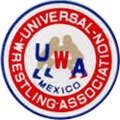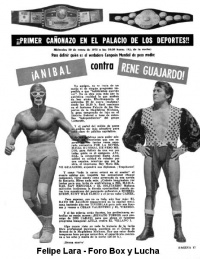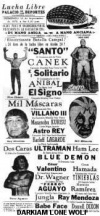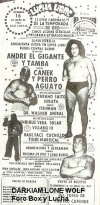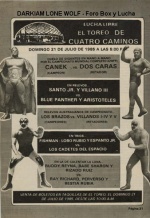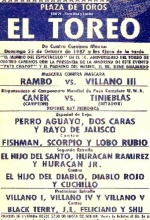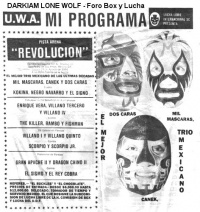LLI: Difference between revisions
No edit summary |
m (wrong Mora!) |
||
| (20 intermediate revisions by 6 users not shown) | |||
| Line 1: | Line 1: | ||
[[Image:uwalogo.jpg|right]]Lucha Libre Internaciónal (LLI) was a Mexican lucha libre promotion from 1975 to | [[Image:Uwalogo1.png|left|100px]][[Image:uwalogo.jpg|right]]Lucha Libre Internaciónal (LLI) was one of a group of names used to refer to a Mexican lucha libre promotion from 1975 to around 1996. The promotion rivaled and even surpassed [[EMLL]] as the top promotion in Mexico during its existence. | ||
This same promotion can be referred to by several names | |||
[[Canek]], [[Villano III]], [[Fishman]], and [[Perro Aguayo]] were some of the stars of the promotion. | * It's most well known internationally as ''UWA'', the Universal Wrestling Association, after the mostly-fictional sanctioning body for their championships. The UWA was originally a US-based promotion, though it had ceased to meaningfully exist by the time the Mexico group started using that name. [[Lou Thesz]] worked with both groups and may have been the link. The bigger idea was to link the Mexico-based promotion with a worldwide group, similar to EMLL's relationship with the NWA. The promotion itself didn't call itself UWA, but the promotion names were not emphasized at the time and the UWA name has stuck. | ||
* The group was originally promoter under the name ''Promociones Mora y Asociados'', often shortened to 'Mora'. [[Francisco José Flores]] was actually the lead promoter, working [[Benjamin Mora Orta]] in the first year of the company. Mora passed away in 1973 and the promotion continued to use his name until Flores passed away. | |||
* After Flores death in 1987, his second-in-charge [[Carlos Maynes]] took over and the promotion was renamed '''LLI''' (Lucha Libre Internacional.) The LLI name was used until through the end of the promotion. | |||
[[Image:Uwa5.jpg|200px|right]]LLI started as a group of wrestlers and promoters splitting from [[EMLL]]. There had been no national rival group to [[EMLL]] since the death of the [[Televicentro]] promotion in the early 50s. Mexico instead had a loose network of promoters outside of Mexico City, some of who would pay EMLL to bring in talent and some who would use local or unaffiliated wrestlers. There had also been a steady growth of luchadors outside of the EMLL system. Wrestling schools were producing more capable wrestlers than could be employed. Young wrestlers were unable to advance in EMLL (or even get booked there). The luchadors at the very top of EMLL tended to leave the promotion as well, feeling they do could do better on their own working non-EMLL affiliated indies without EMLL taking a cut of their booking fee. LLI came into existence as a way to better coordinate those non-EMLL promoters and wrestlers. | |||
A distinct business difference between the promotions were the rights of the luchadors. EMLL strictly controlled their wrestler's schedule, while LLI wrestlers were more independent and could make their own schedules. | |||
The first show LLI took place on [[January 29]], [[1975]] at El [[Palacio de los Deportes]]. The promotion's first show in El Toreo de Naucalpan took place in 1977. | |||
[[Canek]], [[Villano III]], [[Fishman]], and [[Perro Aguayo]] were some of the stars of the promotion. | |||
LLI had working agreements with [[New Japan Pro Wrestling]] and the [[World Wrestling Federation]], and often brought in foreign talent to work short programs with their company stars. Many, like the [[Blue Blazer]], were only really notable as a footnote when the wrestler involved achieved fame elsewhere, but a big part of the promotion was centered around nominally rudo [[Canek]] defending Mexican pride (and the [[UWA World Heavyweight Championship]]) against foreign scourges, including [[Hulk Hogan]], [[Vader]], and [[Andre the Giant]]. | LLI had working agreements with [[New Japan Pro Wrestling]] and the [[World Wrestling Federation]], and often brought in foreign talent to work short programs with their company stars. Many, like the [[Blue Blazer]], were only really notable as a footnote when the wrestler involved achieved fame elsewhere, but a big part of the promotion was centered around nominally rudo [[Canek]] defending Mexican pride (and the [[UWA World Heavyweight Championship]]) against foreign scourges, including [[Hulk Hogan]], [[Vader]], and [[Andre the Giant]]. | ||
LLI faded away in the early 90s. The old stars had been on top too long, and they were unable to create new ones. Talent left for CMLL, looking for better money and opportunity. | Other international stars who worked at UWA were [[Lou Thesz]], [[Tatsumi Fujinami]], [[Tiger Mask]] I (Satoru Sayama), [[Riki Choshu]], [[Antonio Inoki]], [[Abdullah the Butcher]], [[Carlos Colón]], [[Búfalo Allen]], [[Stan Hansen]], [[Tiger Jeet Singh]], [[Jushin Liger]], [[Chris Benoit]], [[Bam Bam Bigelow]], [[Kokina]] (Yokozuna) and 2 Cold Scorpio ([[Black Scorpio]]). | ||
The original referees of the group were [[Miguel Camarena]], [[Carlos Duarte|Carlos "El Brujo" Duarte]] and [[Pompin|Alfonso "El Pompin" Ramirez]]. [[Shadito Cruz]] and [[El Fresero]] would later join the ranks of referees. | |||
LLI faded away in the early 90s. The old stars had been on top too long, and they were unable to create new ones. Televisa broadcasting CMLL shows and LLI appearing on a much weaker station firmly established as LLI being the secondary group. Talent left for CMLL, looking for better money and opportunity. The start of [[AAA]] further drained wrestlers from LLI, and turned them into the #3 promotion in a country that had never supported three full time promotions. In 1994 and 1995, AAA and LLI copromoted a few events named ''Double Power'', which turned into AAA absorbing a few more LLI wrestlers after the deal fell apart. LLI limped along in 1995 and 1996 before fading away. There doesn't appear to be an official final show or closing announcement (or they had fallen so far that it's been lost to history); they just faded away. Carlos Maynes continued to promote in his hometown of Queretaro and was originally brought to shows as a symbol of that LLI era. | |||
The UWA championships continue to be defended and traded years after the promotion dissolved. While they continue the line of previously established champions, the UWA belts are now owned property of individual wrestlers or promoters. Some of the belts have been acquired by Japanese promotions to connect them with the lucha libre style. The Mexico-based belts are mostly vanity titles, existing so the owner can promote himself as a champion, with occasional feuds over the belt. | The UWA championships continue to be defended and traded years after the promotion dissolved. While they continue the line of previously established champions, the UWA belts are now owned property of individual wrestlers or promoters. Some of the belts have been acquired by Japanese promotions to connect them with the lucha libre style. The Mexico-based belts are mostly vanity titles, existing so the owner can promote himself as a champion, with occasional feuds over the belt. | ||
| Line 13: | Line 29: | ||
[[Image:Uwa2.jpg|100px]] | [[Image:Uwa2.jpg|100px]] | ||
[[Image:Uwa3.jpg|100px]] | [[Image:Uwa3.jpg|100px]] | ||
[[Image:Uwa1.jpg| | [[Image:Uwa1.jpg|150px]] | ||
[[Image:V3 rambo 87.jpg| | [[Image:V3 rambo 87.jpg|150px]] | ||
[[Image:Uwa4.jpg| | [[Image:Uwa4.jpg|200px]] | ||
<BR> | <BR> | ||
Latest revision as of 13:36, 14 July 2023
Lucha Libre Internaciónal (LLI) was one of a group of names used to refer to a Mexican lucha libre promotion from 1975 to around 1996. The promotion rivaled and even surpassed EMLL as the top promotion in Mexico during its existence.
This same promotion can be referred to by several names
- It's most well known internationally as UWA, the Universal Wrestling Association, after the mostly-fictional sanctioning body for their championships. The UWA was originally a US-based promotion, though it had ceased to meaningfully exist by the time the Mexico group started using that name. Lou Thesz worked with both groups and may have been the link. The bigger idea was to link the Mexico-based promotion with a worldwide group, similar to EMLL's relationship with the NWA. The promotion itself didn't call itself UWA, but the promotion names were not emphasized at the time and the UWA name has stuck.
- The group was originally promoter under the name Promociones Mora y Asociados, often shortened to 'Mora'. Francisco José Flores was actually the lead promoter, working Benjamin Mora Orta in the first year of the company. Mora passed away in 1973 and the promotion continued to use his name until Flores passed away.
- After Flores death in 1987, his second-in-charge Carlos Maynes took over and the promotion was renamed LLI (Lucha Libre Internacional.) The LLI name was used until through the end of the promotion.
LLI started as a group of wrestlers and promoters splitting from EMLL. There had been no national rival group to EMLL since the death of the Televicentro promotion in the early 50s. Mexico instead had a loose network of promoters outside of Mexico City, some of who would pay EMLL to bring in talent and some who would use local or unaffiliated wrestlers. There had also been a steady growth of luchadors outside of the EMLL system. Wrestling schools were producing more capable wrestlers than could be employed. Young wrestlers were unable to advance in EMLL (or even get booked there). The luchadors at the very top of EMLL tended to leave the promotion as well, feeling they do could do better on their own working non-EMLL affiliated indies without EMLL taking a cut of their booking fee. LLI came into existence as a way to better coordinate those non-EMLL promoters and wrestlers.
A distinct business difference between the promotions were the rights of the luchadors. EMLL strictly controlled their wrestler's schedule, while LLI wrestlers were more independent and could make their own schedules.
The first show LLI took place on January 29, 1975 at El Palacio de los Deportes. The promotion's first show in El Toreo de Naucalpan took place in 1977.
Canek, Villano III, Fishman, and Perro Aguayo were some of the stars of the promotion.
LLI had working agreements with New Japan Pro Wrestling and the World Wrestling Federation, and often brought in foreign talent to work short programs with their company stars. Many, like the Blue Blazer, were only really notable as a footnote when the wrestler involved achieved fame elsewhere, but a big part of the promotion was centered around nominally rudo Canek defending Mexican pride (and the UWA World Heavyweight Championship) against foreign scourges, including Hulk Hogan, Vader, and Andre the Giant.
Other international stars who worked at UWA were Lou Thesz, Tatsumi Fujinami, Tiger Mask I (Satoru Sayama), Riki Choshu, Antonio Inoki, Abdullah the Butcher, Carlos Colón, Búfalo Allen, Stan Hansen, Tiger Jeet Singh, Jushin Liger, Chris Benoit, Bam Bam Bigelow, Kokina (Yokozuna) and 2 Cold Scorpio (Black Scorpio).
The original referees of the group were Miguel Camarena, Carlos "El Brujo" Duarte and Alfonso "El Pompin" Ramirez. Shadito Cruz and El Fresero would later join the ranks of referees.
LLI faded away in the early 90s. The old stars had been on top too long, and they were unable to create new ones. Televisa broadcasting CMLL shows and LLI appearing on a much weaker station firmly established as LLI being the secondary group. Talent left for CMLL, looking for better money and opportunity. The start of AAA further drained wrestlers from LLI, and turned them into the #3 promotion in a country that had never supported three full time promotions. In 1994 and 1995, AAA and LLI copromoted a few events named Double Power, which turned into AAA absorbing a few more LLI wrestlers after the deal fell apart. LLI limped along in 1995 and 1996 before fading away. There doesn't appear to be an official final show or closing announcement (or they had fallen so far that it's been lost to history); they just faded away. Carlos Maynes continued to promote in his hometown of Queretaro and was originally brought to shows as a symbol of that LLI era.
The UWA championships continue to be defended and traded years after the promotion dissolved. While they continue the line of previously established champions, the UWA belts are now owned property of individual wrestlers or promoters. Some of the belts have been acquired by Japanese promotions to connect them with the lucha libre style. The Mexico-based belts are mostly vanity titles, existing so the owner can promote himself as a champion, with occasional feuds over the belt.
| Universal Wrestling Association Championships |
|---|
| Official: Heavy (Dr. Wagner Jr.) |
| Outlaw: Light (Kato Kung Lee Jr.), Junior Light Heavy (Diluvio Negro II) |
| Now in Japan: Welter, Middle, Junior Heavy, Tag, Trios, |
| Defunct: Feather, Light Heavy, Women, International Women, Women Junior, Women's Tag, |
| Associated: WWF Light Heavy |
| This article is a stub of a yet to be completed article. Free to add your own details to this article |
|---|
